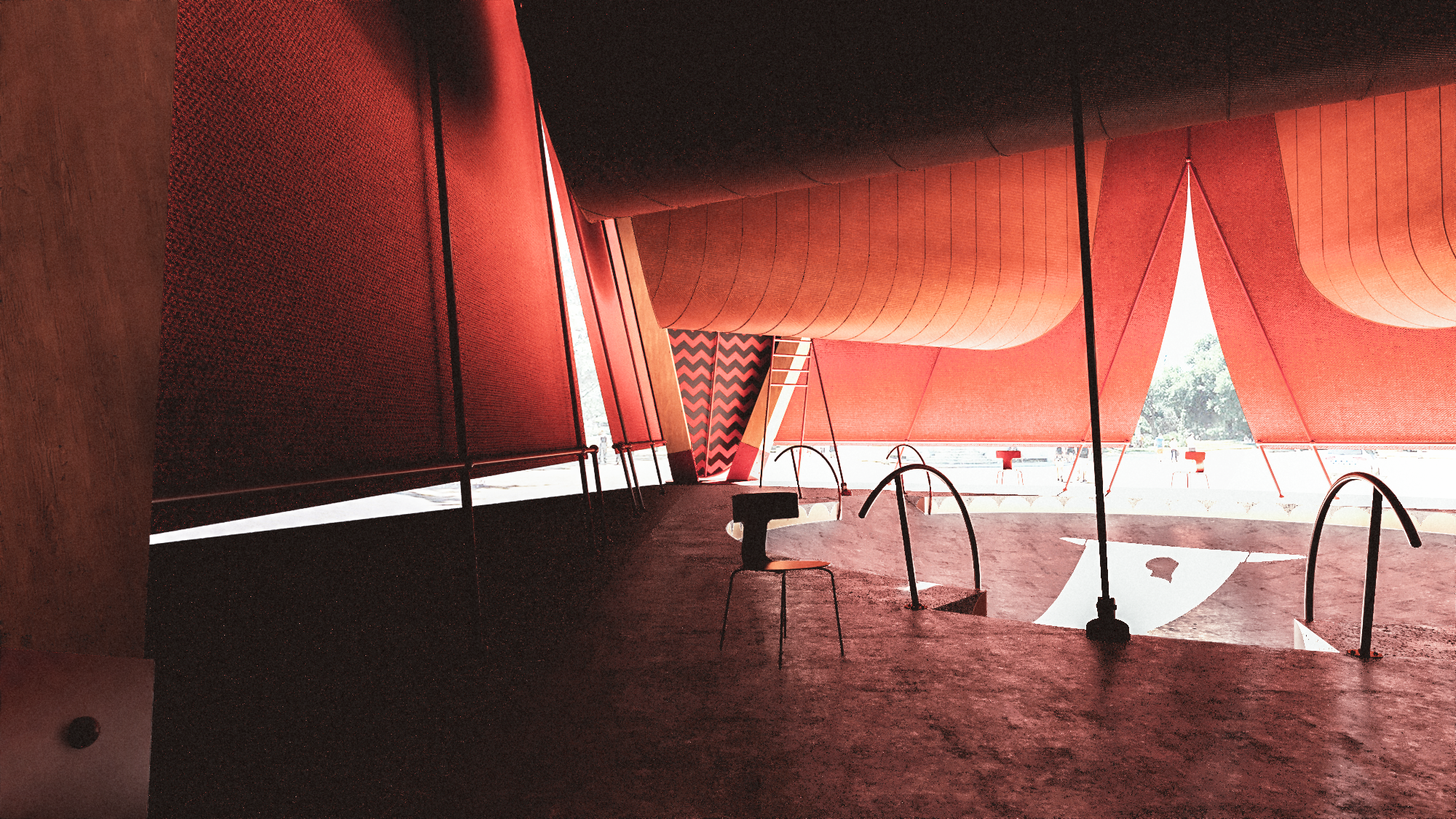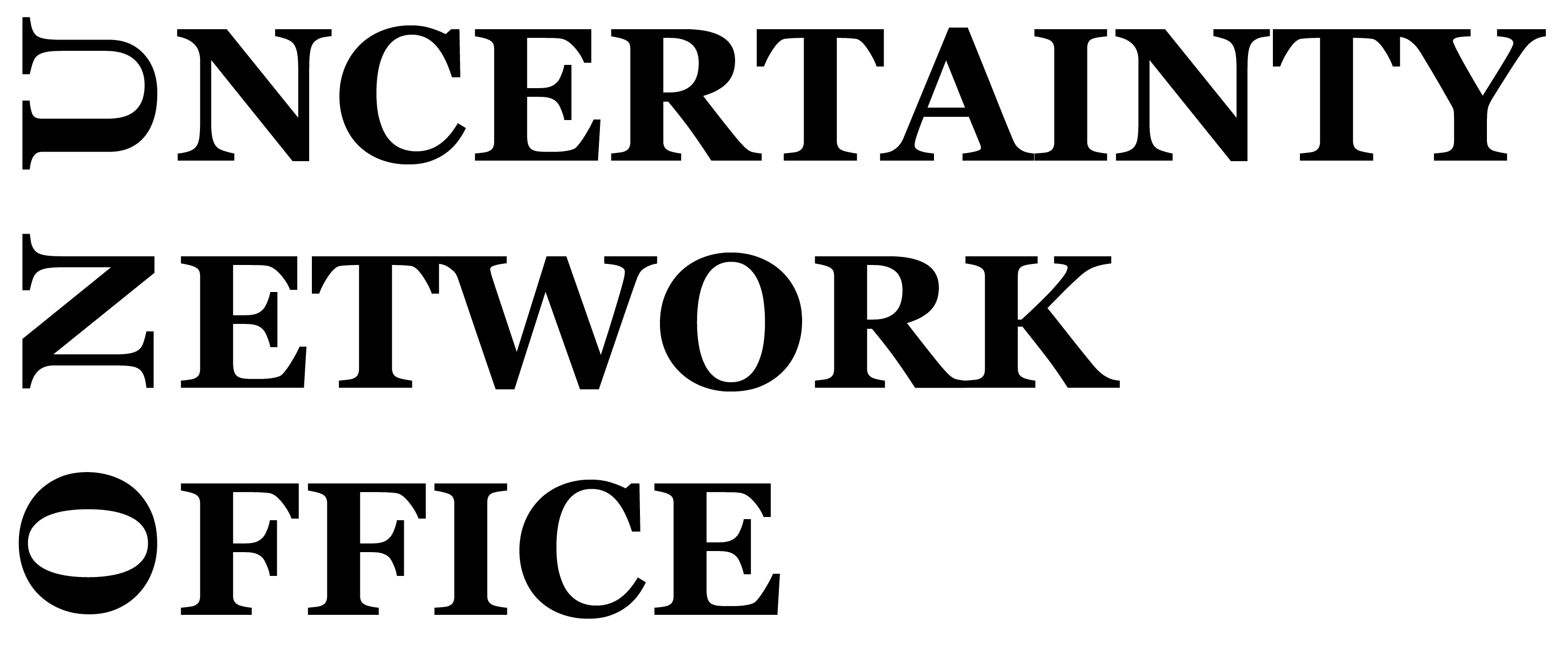A THEATER WITH INCLINING TENT & POSTS
2022, Barcelona, Spain

The site is on a dilapidated weedy plot in the residential area of downtown Malaga. The site is at the junction of the city and forest. To the east is a residential area and the central tourism area, just five minutes’ walk from Plaza Santa Maria, Plaza de la Merced and Cervantes Theatre; on the west is a hillside with olive trees leading to Castillo Gibralfaro.
The house is a circular tunnel filled with wind, sunlight and shadows. The exterior of the house maintains the form of a pitched roof house echoing Malaga context, while the interior is a continuous arcade. The interior camber provides a sense of primitivity, a metaphor of the cave. The concrete camber turns into a handmade pottery container offering cosy and restful residence. I always think of a photo of the Salvatore Fiume clay sculpture studio, the arched ceiling and the curved clay sculptures make up a tranquil, mysterious and even sacred spectacle. Because of the curved form and handmade texture, everything looks soft and gentle. The light diffuses and dyes the chamber with shadow; all the boundaries gradually dissolve in lightness and darkness.
“The curve is like a request that changes the sense of space (distance and perspective), the sense of volume, and the relationship between the most critical objects in the painting. The curve begins to define the clear spatial direction in the plane, and the expansion, reduction and flow in the space." When people and life enter this space, people are more likely to navigate the space, and each segment of life turn out to be integrated into this continuous field, which was called the “Dynamic Zone” by Toyo Ito. And Ito creates this poetic space in the “House Nakano”, also known as “White U”. In this circular house built for his old sister following the loss of her husband, Ito hopes to use this curved space to provide a soft, gentle and quiet harbor. The pure white interior space dissolves light and air making them part of the wall and space. Ito hopes that his sister can dive in this air-like space to dissolve the sadness of the past. Ito also designs a central “Dormant Zone” to provide a peaceful space without any disturbing : a yard with black soil surrounding by circular concrete wall. In our project, the blakc soiled yard was replaced by a mirror-like pool incubating powerful silence.Ripples indicate the wind which are integrated with water.
Erik Bryggman's Revival Church in Finland's Turku is also a crucial precedent for this project. Staggered axis, curved ceilings, lowered side porches and altar leading to the courtyard creates a sense of sacredness leading to elsewhere. The dim and tunnel-like hall leads pilgrims’ sight naturally to the altar illuminated by daylight. The vines on altar backwall suggest the courtyard on the east side, which also metaphorizes revival and hope. In this house with wind & water, the ring layout makes sights without ends, leading “to elsewhere”. Light and shadow, like pathfinders, alternatively dance at the end of sights, making the “tunnel” more mysterious and generous.
![]()
The house is a circular tunnel filled with wind, sunlight and shadows. The exterior of the house maintains the form of a pitched roof house echoing Malaga context, while the interior is a continuous arcade. The interior camber provides a sense of primitivity, a metaphor of the cave. The concrete camber turns into a handmade pottery container offering cosy and restful residence. I always think of a photo of the Salvatore Fiume clay sculpture studio, the arched ceiling and the curved clay sculptures make up a tranquil, mysterious and even sacred spectacle. Because of the curved form and handmade texture, everything looks soft and gentle. The light diffuses and dyes the chamber with shadow; all the boundaries gradually dissolve in lightness and darkness.
“The curve is like a request that changes the sense of space (distance and perspective), the sense of volume, and the relationship between the most critical objects in the painting. The curve begins to define the clear spatial direction in the plane, and the expansion, reduction and flow in the space." When people and life enter this space, people are more likely to navigate the space, and each segment of life turn out to be integrated into this continuous field, which was called the “Dynamic Zone” by Toyo Ito. And Ito creates this poetic space in the “House Nakano”, also known as “White U”. In this circular house built for his old sister following the loss of her husband, Ito hopes to use this curved space to provide a soft, gentle and quiet harbor. The pure white interior space dissolves light and air making them part of the wall and space. Ito hopes that his sister can dive in this air-like space to dissolve the sadness of the past. Ito also designs a central “Dormant Zone” to provide a peaceful space without any disturbing : a yard with black soil surrounding by circular concrete wall. In our project, the blakc soiled yard was replaced by a mirror-like pool incubating powerful silence.Ripples indicate the wind which are integrated with water.
Erik Bryggman's Revival Church in Finland's Turku is also a crucial precedent for this project. Staggered axis, curved ceilings, lowered side porches and altar leading to the courtyard creates a sense of sacredness leading to elsewhere. The dim and tunnel-like hall leads pilgrims’ sight naturally to the altar illuminated by daylight. The vines on altar backwall suggest the courtyard on the east side, which also metaphorizes revival and hope. In this house with wind & water, the ring layout makes sights without ends, leading “to elsewhere”. Light and shadow, like pathfinders, alternatively dance at the end of sights, making the “tunnel” more mysterious and generous.


Two strips of light running through the ring extend the mysteriousness and generosity. One comes from the disjointed wall and the base (the mound); the strip light draws shading on the ground. And the height difference of 1.5 meters and the ramp at both ends let the light belt rise from the ground to the eye and down to the ankle again. Walking around the pool, you can see the light under your feet slowly turns into the bright spectacle in front of you. The other strip light comes from the gap between the wall and the roof, gently pouring from top to bottom of the wall into the pool. The gap brings light as well as wind and rain. The wind dance through from the ankle while the rain drips from the gap of the skylight and shades the wall with the light. Light, wind and rain frequently play and flirt with people. This is a tranquil and intimate ring as a “public” space for people, house and nature.







The central pool becomes the "outlet" of this enclosed ring, reflecting, suggesting and leading to the sky. The wind tunnel-like wall surrounding the pool leads sights up and further into the sky. This water is flush with the line of sight in the living space and studio, suspended in front of the eyes like a mirror art or a dish. The semi-circular platform in front of the water is the starting point and end point of the house. It connects the dining area and the studio, the worldly life and spiritual practice. It is an altar, sitting there you can pray and meditate; you can also idle and sleep. It greets the sun and nonsense.




